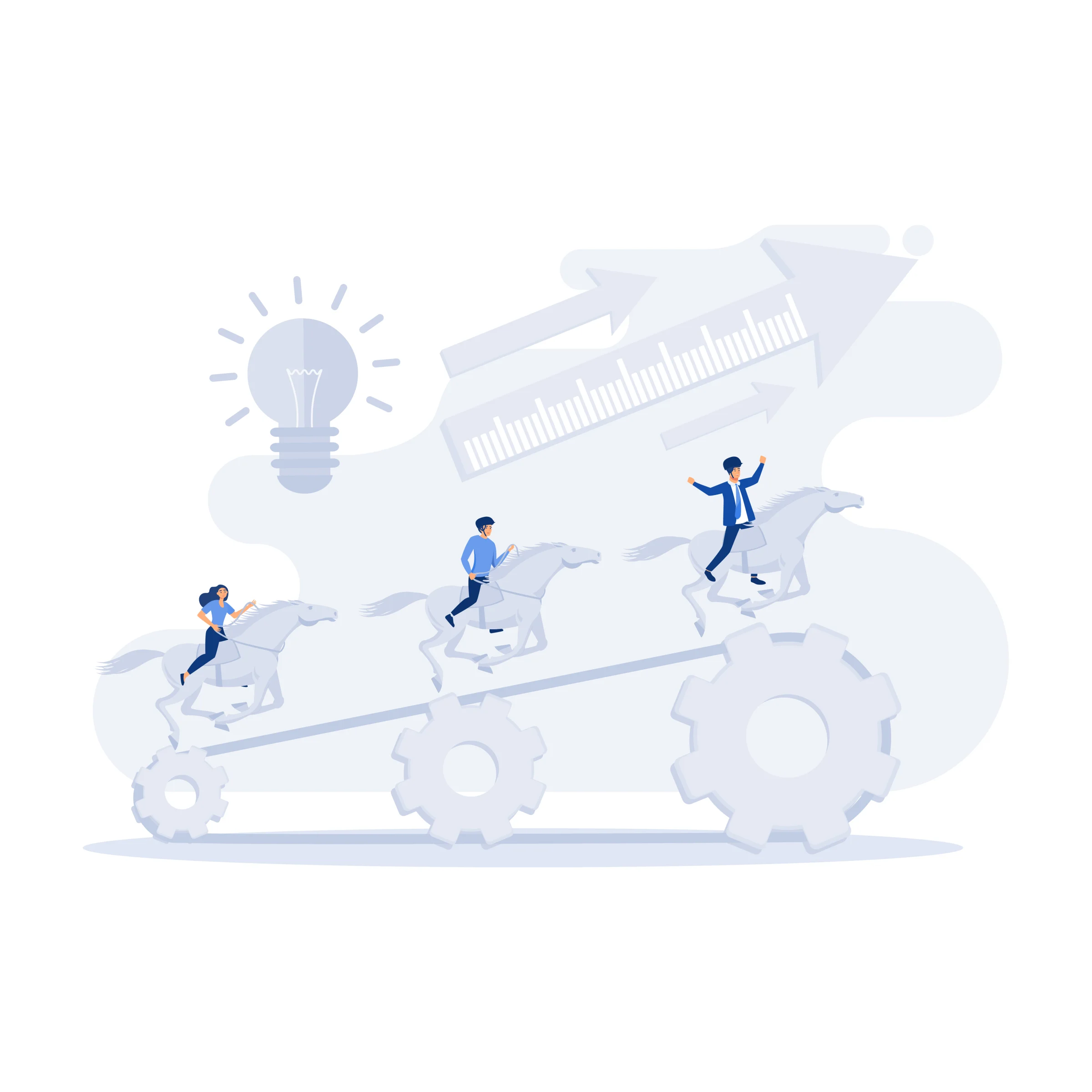Personality types: How you can lead and support your employees individually
Risk-takers, emotional, reserved—each person has a unique personality. Your employees are characterized by different traits and needs. This type of diversity is an asset to your team. At the same time, it presents you with challenges as a leader: How do you best handle different types of employees? Why are certain working conditions motivating for some in the team and frustrating for others? In this article, you will learn which four personality types are distinguished by the well-known DISC model and how you can support these four types in realizing their full potential.
The four types of the DISC model
The DISC model is a widely used personality model. It was developed in the 1920s by William Moulton Marston and divides people into four personality types:
- D ominant type
- I nfluence type
- S teadiness type
- C onscientiousness type
Learn more about the four types of DISC models below. Bear in mind that any type of classification is a simplification of reality. No one matches a profile 100%. We are all an individual mix of many different traits that even scientific personality tests can never fully represent. Nevertheless, type models like the DISC model can be very helpful to better assess your fellow human beings and to build mutual understanding. So, feel free to use the model as a guide for type-appropriate leadership!

Dominant type (D-type)
Personality traits of the dominant type
Dominant types are strategists. They have a good eye for the big picture, are quick to develop effective strategies, and like to get things done. They are willing to take risks to achieve their goals and accomplish extraordinary things. They make decisions quickly but based on facts and reason.
Their hands-on mentality, ambition and strong-will bring out their dominance. This can be seen in their confident body language, direct eye contact, and energetic communication style. Others sometimes perceive D-types as impatient, aggressive or bossy because of their fast pace and assertiveness.
In a team, dominant types are motivating and driving. Their high performance and focus on results can be contagious. D types are often found in leadership positions and roles of high responsibility.
Leadership tips for the dominant type
Your dominant employees want clarity and space from you as a manager to develop their own strategies.
- Create a forward-thinking work environment for the dominant types on your team, where they can quickly grasp facts and figures.
- Get to the point quickly when talking to D-types. Communicate clearly and concisely.
- Assign them challenging tasks that require new ideas. Routine tasks are less suitable. Then give them appropriate recognition for their efforts.
- Dominant employee types can usually take criticism well and have a solution-oriented mindset. Therefore, find clear words when conflicts arise and address measures to improve performance directly.
- Support D-types in their development by letting them work out solutions on their own. But you should also work with them to identify risks and obstacles that need to be considered and taken into account in spite of their doer mentality.

Influence type (I-type)
Personality traits of the influence type
Influence types are idealists and innovative leaders. It suits them to develop creative ideas. Similar to dominant types, they see the big picture. Instead of acting rationally and strategically, however, influencing types act emotionally and intuitively. Building large networks is important to them—and one of their greatest strengths. They like to be the center of attention, are talkative and are not afraid to approach others and put themselves out there.
Due to their action-oriented nature, I-types like to take initiative. It is not uncommon for them to attract attention with their extravagant appearance and prove to be performers with a captivating charm. Although influence types are very communicative, they sometimes rub people the wrong way and are perceived as hectic or self-centered.
In a team, influence employees play an inspirational role. They are also adept at networking .
Leadership tips for the influence type
People with influence qualities have a strong need for autonomy, even at work. Your job as a manager is to provide the structure that this personality type finds difficult to create.
- Provide I-types with a work environment and activities they can identify with.
- Don't just talk to them about facts and figures, engage them. Make sure there is still a common goal.
- Analytical tasks are difficult for influence types. In contrast, they flourish in activities with lots of human interaction. If you set clear instructions and check progress regularly, you will provide a structured framework.
- I-types are quick to take criticism personally. They react strongly emotionally or try to downplay the problem when they realize they cannot avoid a conflict. The key here is to stay the course, not get distracted and be clear about the problem.
- Always keep the I-type's development focused on specific goals. Set detailed action plans together and evaluate development at regular intervals.

Steadiness type (S-type)
Personality traits of the steadiness type
Steadiness types are relationship-oriented people through and through. It is important to them that everyone in the team feels comfortable and gets along well with each other. They value harmonious coexistence and actively contribute to it through their socially oriented, mediating nature. Calm, empathetic and collegial—these are the qualities that characterize S-types. Unlike dominant and influence types who see the "big picture," steadiness types have an eye for details.
Consistency and security are important to them. That's why they're called the "Steadiness type". This is also reflected in their patient communication style and consistent work pace. Their level-headed, team-oriented behavior is sometimes also perceived by those around them as slow, passive or submissive.
For the team, S-types are a central pillar. They make sure that all team members are thought of and are a trusted person for many colleagues. In the event of conflict, they are excellent mediators.
Leadership tips for the steadiness type
Your Type S employees are often there for others on the team. As a manager, be there for them, because they also need someone to turn to. Leading with empathy and offering support is especially important for this type of employee.
- Create a stable work environment for S-types that is not subject to constant change.
- Take ample time to talk with your steadiness types. Show honest interest in them as a person and don't just exchange superficial pleasantries.
- Assigns steadiness types to tasks that require teamwork, routine and attention to detail. Assist them with new or very urgent tasks.
- S-types are conflict averse and take criticism very much to heart. Therefore, use tact when discussing conflicts . Separate critical feedback clearly from praise, and always find positive, complimentary words.
- Be patient and encouraging in supporting the development of S types. Develop a concrete plan with them step by step, encourage them to take action while gently preventing them from retreating into the familiar.

Conscientiousness type (C-type)
Personality traits of the conscientiousness type
Conscientiousness types are analysts. They want to understand the world around them and get to the bottom of things because that's what drives them. Their powers of observation help them to pick up new information quickly and to keep even the smallest details on their radar. When C-types have to make decisions, they carefully weigh different options. They like to base their decisions on data and facts and act very thoughtfully.
C-types value precision and are meticulous about their work. In dealing with others, they are serious and restrained, their appearance is always polished. This can sometimes come across as stiff and reserved to others—and their deliberate behavior can give the impression that they are indecisive.
C-types enrich the team with their rational, thorough approach. They encourage you to analyze problems objectively, look for causes and develop well-thought-out solutions.
Leadership tips for the conscientiousness type
Conscientiousness type employees feel comfortable when work is structured and businesslike. The appropriate leadership style for these team members is delegating tasks .
- Offer C-Types a work environment in which they can do their work thoroughly. One that has clear rules and is not constantly changing.
- Be prepared for conversations with C-types. Structure your request and stay on topic as much as possible. You can use arguments, facts and figures to get through to this personality type.
- Delegate tasks that require accuracy, high concentration and analytical thinking. Praise the detail and quality of the results.
- When conflicts arise, conscientiousness types quickly go into a defensive posture. As they define themselves by their performance, criticism hits them hard. Remain objective and present your arguments in a matter-of-fact manner. You can point to facts if there is a backlash. Then define detailed actions with clear targets and timelines.
- C-types sometimes appear resistant to change. Support their development by giving them time to analyze the new circumstances and adjust to the changes.

Personality models in leadership
To better understand your employees, you can use type models such as the DISC model as a guide. They can give you ideas on how to motivate and manage team members with different personalities—and how to use this diversity to develop high-performing teams.
But don't get too hung up on the model. Even the widely used DISC model offers only a rough categorization of personality traits. Everyone is unique. Show understanding of the different styles and strengths of different personalities and respond empathetically and individually to your employees. This is how you succeed in type-appropriate leadership!
In our e-learning " Type-Appropriate Leadership " you will receive in-depth leadership tips and practical suggestions on how you can better assess the personality types of your employees and also reflect on your own personality.



